About a year and a half ago, as oil prices climbed and the world grew warmer (or colder, or windy-er) I decided I needed to do something to reduce the amount of oil I consumed and waste that I produced, which lead me to start commuting to work via bicyle. Over the one-year-period ending August 31, 2008 I bicycled the 20 mile round trip commute to my place of employment 190 times out of the 285 times that I went into work. Over 4000 miles total, including some pleasure riding.
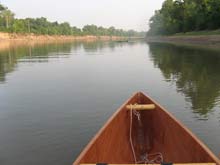 |
I needed to do something to reduce the amount of oil I consumed and waste that I produced.
click images to enlarge |
With some success converting my commute to work into a "low-impact" trip, both environmentally as well as financially, I began to look at how I could repeat that success with boating. About 6 miles from the house, the main road crosses a small river and there is a public access with ramp just across the bridge.
| Spreading the stitched-together panels apart with concrete blocks. |
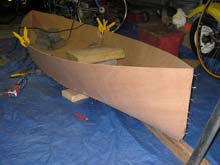 |
Although
the upper reaches of this river, about 100 miles distant, pass through wilderness areas, the lower end near me bears the scares of decades of suburban neglect and abuse. Still, it is close, and I began to make plans to boat on this reach of the river without the benefits and detriments of petroleum distillates.
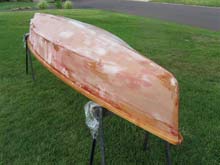 |
Fairing the outside of the hull after glassing with 4 oz. fiberglass cloth & epoxy |
I needed a boat, and it had to be light and it had to be small, as I intended to tow it 6 miles down the road behind a bicycle. I had seen Larry Apelbaum's
beautifully-
rendered "Swamp Yankee" canoe at a couple of Midwest Messabouts and while I did not try using it I still felt that it would be ideal. At just 11 feet by 28 inches, and under 30 lbs it could be easily carried and launched and other than windage would not present too great a drag to the bicycle. When Messing About in Boats published the plans for the Swamp Yankee in a Fall 2007 issue, I knew my plans where coming togther.
| The canoe is about finished and the trailer or cart is coming together. |
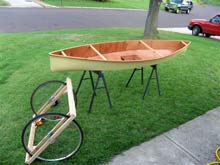 |
Still, I made no headway on the project until Friday, July 4th 2008, when I finally got motivated to start cutting wood. The Swamp Yankee is a "tortured" or "compounded"
plywood design,
and needed very thin, high-quality plywood. I used 3 mm BS 1088 Okoume and covered the
entire outside of the boat with 4 oz fiberglass cloth, with a 3 inch fiberglass tape added along the keel. The inside is merely coated with diluted epoxy while the interior seams have a single
layer of 3 inch fiberglass tape.
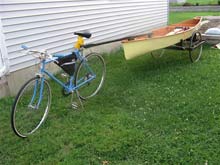 |
The completed rig, hooked-up and ready for the road. |
The Swamp Yankee plans are not very detailed; for example, the hull panels when stitched together try to fold-up flat. One must pry the sides out and brace them in that position.
The directions read, "the boat should look right; if it doesn't look right, wiggle it around a bit
until it looks right..." For the sake of stability and shallow draft, I
wanted to get as shallow
a "V" bottom as I could get, but since the bottom panels are vertical at bow and stern, getting
them close to horizontal amidships imparts some wicked twist in the panels. I set the stitched
hull on the concrete floor of the garage and began to stack bricks and concrete blocks into the hull to flatten-out the bottom. I twisted the panels as much as I dared before I locked the
hull in position by taping the interior seams and glassing in a 1/4" plywood seat panel. The hull
has a bit more "V" than I wanted but I feared any more twisting would have torn the panels. Although Larry used 4mm in his canoe and experienced only minor tearing of the plywood, I would not attempt to build this boat out of plywood thicker than that.
| Details of the wheel mountings on the trailer |
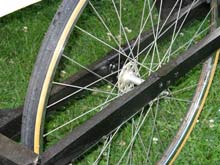 |
In addition to the boat, I also needed a "trailer" to tow the canoe behind a bicycle. I decided to
build a "dolly' of sorts that fastened to the canoe, and a "tow bar" that clamped to the thwarts of the canoe and hitched to the seatpost of the bicycle. My trailer design borrowed heavily from some bicycle utility trailer designs which I found on the web. The 27 inch wheels came from an old Schwinn Varsity 10 speed which I had orignally purchased in order to get fenders for another old Schwinn that I use as a commuter bicycle. The frame of the dolly is wood, glued together with epoxy, while the "drop-outs", or brackets that the wheels bolt to, where fashioned
out of steel covers for 4 inch electrical boxes. Since bicycle wheels are fitted with very short axles that require support on both sides of the wheel, the dolly has stringers on both sides of each wheel. Cradle supports where cut to fit the hull, padded with split plastic tubing,
and screwed to the dolly frame. The supports can be replaced with other supports should the dollar be used with a different boat.
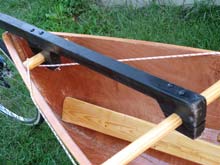 |
The tow arm fastened to the canoe. |
The tow bar is laminated from (2) layers of 3/4" by 1 1/2" pine. It clamps to the bow "carry handle"
and also the forward thwart, said thwart installed expressly for use with the tow bar, as I don't feel the canoe needs it otherwise. A turnbuckle bolted to the bicycle-end of the tow bar provides an
eyebolt that swivels, and which engages a snap-hook bolted to the bicycle seat post. The swivelling eyebolt in the turnbuckle allows the bicycle to be horizontal while the canoe and dolly remain vertical.
| The 'trailer hitch" is a snap hook on the bicycle and a turnbuckle on the tow arm. |
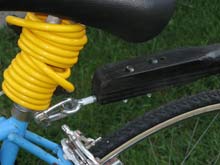 |
Both the canoe and cart were completed by August 5th, only a month after starting. I had also refurbished an old 10-speed Schwinn Continental to be a "tow vehicle." Since I would be leaving the bicycle on
the riverbank, I did not want to leave anything valuable, and the beat-up old 1973 Schwinn fit the bill.
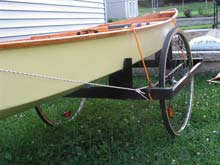 |
The canoe sits on supports cut to fit the contours of the hull, and is held
in place by
bungee cords. |
I choose a quiet Sunday morning for the first trip down to the river. The canoe, at about 28 lbs not including the cart, really did not present much drag on the bicycle, although a strong wind would certainly change that. The looks one gets while pedalling a bicycle while towing a canoe cannot be described, but I ceased worrying about what others think a long time ago.
| On the bridge overlooking the launching spot |
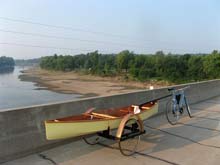 |
The canoe itself proved to be quite stable once one was in it, but getting in and out is an artform.
I usually get in by wading into ankle-deep water, spreading my legs wide, sliding the canoe
between them, and more-or-less falling into the seat. Getting out is a bit more difficult unless one grounds-out the canoe in very shallow water so as to stabilize it.
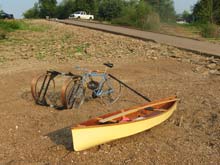 |
Unloading at the launch site. |
One the second trip down to the river I had an incident involving an uneven expansion joint in the pavement which lead to some damage to the bicycle, some fiberglass scraped off the stem of the canoe, and some skin scraped off me. The canoe was easy enough to repair, a bent wheel was straightened on the bike, and I pretty much healed-up although was quite sore for about a week.
| Fiberglass repairs after an "incident" on the road |
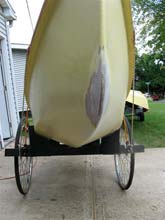 |
Some localized flooding, due to the remnants of Hurricane Ike, have put a temporary halt to my "cycle-canoeing," but fall is here and the water levels are dropping and I am looking forward to some more quiet canoeing as the leaves turn TO the shades of autumn. The river is a perfect place to contemplate future projects, such as a sailboat.
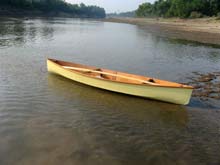 |
Afloat and ready to voyage. Paddle is a narrow-bladed "greenland" style
double-bladed paddle
cut from a 2 by 4 stud from the home center. |
But that might be too big to tow behind the bicycle.
Or is it.....
***** |

